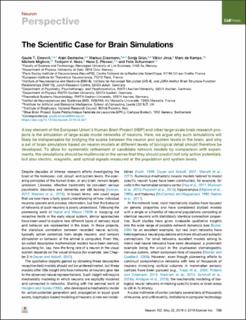| dc.contributor.author | Einevoll, Gaute T. | |
| dc.contributor.author | Destexhe, Alain | |
| dc.contributor.author | Diesmann, Markus | |
| dc.contributor.author | Grün, Sonja | |
| dc.contributor.author | Jirsa, Viktor | |
| dc.contributor.author | de Kamps, Marc | |
| dc.contributor.author | Migliore, Michele | |
| dc.contributor.author | Ness, Torbjørn V. | |
| dc.contributor.author | Plesser, Hans E. | |
| dc.contributor.author | Schürmann, Felix | |
| dc.date.accessioned | 2020-05-15T09:23:34Z | |
| dc.date.available | 2020-05-15T09:23:34Z | |
| dc.date.issued | 2019-05-22 | |
| dc.identifier.uri | https://hdl.handle.net/11250/2654608 | |
| dc.description.abstract | A key element of the European Union’s Human Brain Project (HBP) and other large-scale brain research pro- jects is the simulation of large-scale model networks of neurons. Here, we argue why such simulations will likely be indispensable for bridging the scales between the neuron and system levels in the brain, and why a set of brain simulators based on neuron models at different levels of biological detail should therefore be developed. To allow for systematic refinement of candidate network models by comparison with experiments, the simulations should be multimodal in the sense that they should predict not only action potentials, but also electric, magnetic, and optical signals measured at the population and system levels. | en_US |
| dc.language.iso | eng | en_US |
| dc.publisher | CellPress | en_US |
| dc.title | The Scientific Case for Brain Simulations | en_US |
| dc.type | Journal article | en_US |
| dc.subject.nsi | Nevrovitenskap | en_US |
| dc.source.pagenumber | 735-744 | en_US |
| dc.source.volume | 102 | en_US |
| dc.source.journal | Neuron | en_US |
| dc.source.issue | 4 | en_US |
| dc.identifier.doi | 10.1016/j.neuron.2019.03.027 | |
| dc.relation.project | EU/FP7/720270 | en_US |
| dc.relation.project | EU/FP7/785907 | en_US |
| dc.relation.project | Norges forskningsråd: 248828 | en_US |
| dc.relation.project | Norges forskningsråd: 250128 | en_US |
